Stability Analysis of Surrounding Rock in Paste Backfill Recovery of Residual Room Pillars
Abstract
:1. Introduction
2. Overview of the Study Area
3. Paste Backfill Recovery Method for Residual Room Pillars
3.1. Principles Underlying Paste Backfill Recovery of Residual Room Pillars
3.2. Process for Paste Backfill Recovery of Residual Room Pillars
4. Selection and Optimization of Paste-Backfilling Materials
4.1. Selection of Paste-Backfilling Materials
4.2. Optimizing the Ratio of Paste-Backfilling Materials
5. Stability Analysis of Surrounding Rock of the Stope under Recovery of Residual Coal Pillars
5.1. Building a Numerical Model
5.2. Results and Analysis
5.2.1 Paste-Backfilled Pillar and Coal Pillar Failure Properties
5.2.2. Vertical Stress Distribution Properties of the Stope
5.2.3. Surface Deformation Characteristics
6. Conclusions
Author Contributions
Acknowledgments
Conflicts of Interest
References
- Li, X.; Xue, Y.; Feng, J.; Yi, Q.; Li, W.; Guo, X.; Liu, K. Co-pyrolysis of lignite and Shendong coal direct liquefaction residue. Fuel 2015, 144, 342–348. [Google Scholar] [CrossRef]
- Zhang, D.; Fan, G.; Ma, L.; Wang, X. Aquifer protection during longwall mining of shallow coal seams: A case study in the Shendong Coalfield of China. Int. J. Coal Geol. 2011, 86, 190–196. [Google Scholar] [CrossRef]
- Zhang, Y.; Wu, J.; Chang, L.; Wang, J.; Xue, S.; Li, Z. Kinetic and thermodynamic studies on the mechanism of low-temperature oxidation of coal: A case study of Shendong coal (China). Int. J. Coal Geol. 2013, 120, 41–49. [Google Scholar] [CrossRef]
- Chen, Y.; Ma, S.; Cao, Q. Extraction of the remnant coal pillar in regular and irregular shapes: A case study. J. Loss Prev. Process Ind. 2018, 55, 191–203. [Google Scholar] [CrossRef]
- Ghasemi, E.; Shahriar, K. A new coal pillars design method in order to enhance safety of the retreat mining in room and pillar mines. Saf. Sci. 2012, 50, 579–585. [Google Scholar] [CrossRef]
- Jin, G.; Wang, L.G.; Zhang, J.H.; Hu, M.J.; Duan, N. Roadway layout for recycling residual coal pillar in room-and-pillar mining of thick coal seam. Int. J. Min. Sci. Technol. 2015, 25, 729–734. [Google Scholar] [CrossRef]
- Zhou, N.; Li, M.; Zhang, J.; Gao, R. Roadway backfill method to prevent geohazards induced by room and pillar mining: A case study in Changxing coal mine, China. Nat. Hazards Earth Syst. Sci. 2016, 16, 2473–2484. [Google Scholar] [CrossRef]
- Zhou, Y.J.; Li, M.; Xu, X.D.; Li, X.T.; Ma, Y.D.; Ma, Z.G. Research on Catastrophic Pillar Instability in Room and Pillar Gypsum Mining. Sustainability 2018, 10, 3773. [Google Scholar] [CrossRef]
- Luan, H.J.; Lin, H.L.; Jiang, Y.J.; Wang, Y.H.; Liu, J.K.; Wang, P. Risks Induced by Room Mining Goaf and Their Assessment: A Case Study in the Shenfu-Dongsheng Mining Area. Sustainability 2018, 10, 631. [Google Scholar] [CrossRef]
- Sherizadeh, T.; Kulatilake, P.H.S.W. Assessment of roof stability in a room and pillar coal mine in the US using three-dimensional distinct element method. Tunn. Undergr. Space Technol. 2016, 59, 24–37. [Google Scholar] [CrossRef]
- Singh, R.; Mandal, P.K.; Singh, A.K.; Kumar, R.; Sinha, A. Coal pillar extraction at deep cover: With special reference to Indian coalfields. Int. J. Coal Geol. 2011, 86, 276–288. [Google Scholar] [CrossRef]
- Tang, H.B.; Liu, D.P.; Wang, S.Q. Roof Stress Analysis and Roof Pressure Observation in Residual Coal Mining after Room and Pillar Mining. Coal Technol. 2015, 34, 37–39. [Google Scholar]
- Zhang, J.X.; Huang, P.; Zhang, Q.; Li, M.; Chen, Z.W. Stability and control of room mining coal pillars-taking room mining coal pillars of solid backfill recovery as an example. J. Cent. South Univ. 2017, 24, 1121–1132. [Google Scholar] [CrossRef]
- Miao, X.X.; Zhang, J.X.; Guo, G.L. Study on waste-filling method and technology in fully-mechanized coal mining. J. China Coal Soc. 2010, 35, 1–6. [Google Scholar]
- Zhang, Y.; Cao, S.; Guo, S.; Wan, T.; Wang, J. Mechanisms of the development of water-conducting fracture zone in overlying strata during shortwall block backfill mining: A case study in Northwestern China. Environ. Earth Sci. 2018, 77, 543. [Google Scholar] [CrossRef]
- Deng, X.J.; Zhang, J.X.; Zhou, N.; Wit, B.D.; Wang, C.T. Upward slicing longwall-roadway cemented backfilling technology for mining an extra-thick coal seam located under aquifers: A case study. Environ. Earth Sci. 2017, 76, 789. [Google Scholar] [CrossRef]
- Guo, W.; Wang, H.; Chen, S. Coal pillar safety and surface deformation characteristics of wide strip pillar mining in deep mine. Arab. J. Geosci. 2016, 9, 1–9. [Google Scholar] [CrossRef]
- Sun, Q.; Zhang, X.D.; Yang, Y. Creep constitutive model of cemented body used in backfilling mining. J. China Coal Soc. 2013, 38, 994–1000. [Google Scholar]
- Wu, D.; Deng, T.F.; Zhao, P.K. A coupled THMC modeling application of cemented coal gangue-fly ash backfill. Constr. Build. Mater. 2018, 158, 326–336. [Google Scholar] [CrossRef]
- Yilmaz, T.; Ercikdi, B.; Deveci, H. Utilisation of construction and demolition waste as cemented paste backfill material for underground mine openings. J. Environ. Manag. 2018, 222, 250–259. [Google Scholar] [CrossRef]
- Deng, X.J.; Klein, B.; Zhang, J.X.; Hallbom, D.; Wit, B.D. Time-dependent rheological behaviour of cemented backfill mixture. Int. J. Min. Reclam. Environ. 2018, 32, 145–162. [Google Scholar] [CrossRef]
- Wu, D.; Yang, B.; Liu, Y. Transportability and pressure drop of fresh cemented coal gangue-fly ash backfill (CGFB) slurry in pipe loop. Powder Technol. 2015, 284, 218–224. [Google Scholar] [CrossRef]
- Xie, Q.Z. Study on Stability of Roof—Coal Pillar in Room and Pillar Mining Goaf in Shallow Depth Seam. Coal Sci. Technol. 2014, 42, 1–9. [Google Scholar]
- Deng, X.; Zhang, J.; Klein, B.; Zhou, N.; deWit, B. Experimental characterization of the influence of solid components on the rheological and mechanical properties of cemented paste backfill. Int. J. Miner. Process. 2017, 168, 116–125. [Google Scholar] [CrossRef]
- Ghirian, A.; Fall, M. Coupled thermo–hydro–mechanical–chemical behavior of cemented paste backfill in column experiments: Part II: mechanical, chemical and microstructural processes and characteristics. Eng. Geol. 2014, 170, 11–23. [Google Scholar] [CrossRef]
- Donovan, J.G.; Karfakis, M.G. Design of backfilled thin-seam coal pillars using earth pressure theory. Geotechn. Geol. Eng. 2004, 22, 627–642. [Google Scholar] [CrossRef]
- Qiang, S.; Zhang, J.; Nan, Z. Study and discussion of short- strip coal pillar recovery with cemented paste backfill. Int. J. Rock Mech. Min. Sci. 2018, 104, 147–155. [Google Scholar]
- Skrzypkowski, K. Compressibility of materials and backfilling mixtures with addition of solid wastes from flue-gas treatment and fly ashes. E3S Web Conf. 2018, 71. [Google Scholar] [CrossRef]
- Skrzypkowski, K.; Korzeniowski, W.; Poborska-Młynarska, K. Binding Capability of Ashes and Dusts from Municipal Solid Waste Incineration with Salt Brine and Geotechnical Parameters of the Cemented Samples. Arch. Min. Sci. 2018, 63, 903–918. [Google Scholar]
- Yan, H.; Zhang, J.X.; Zhou, N. Shaft failure characteristics and the control effects of backfill body compression ratio at ultra-contiguous coal seams mining. Environ. Earth Sci. 2018, 77, 458. [Google Scholar] [CrossRef]
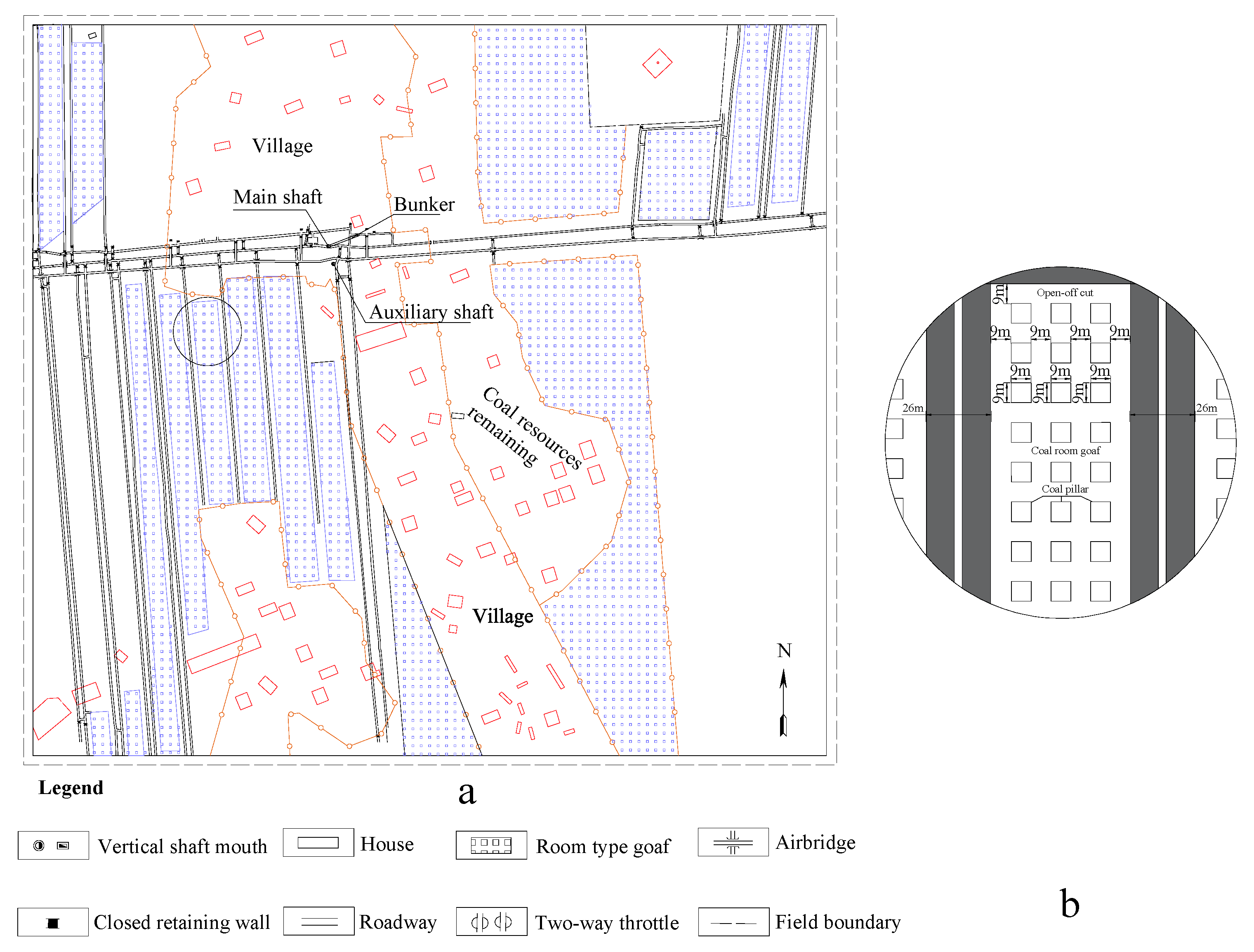
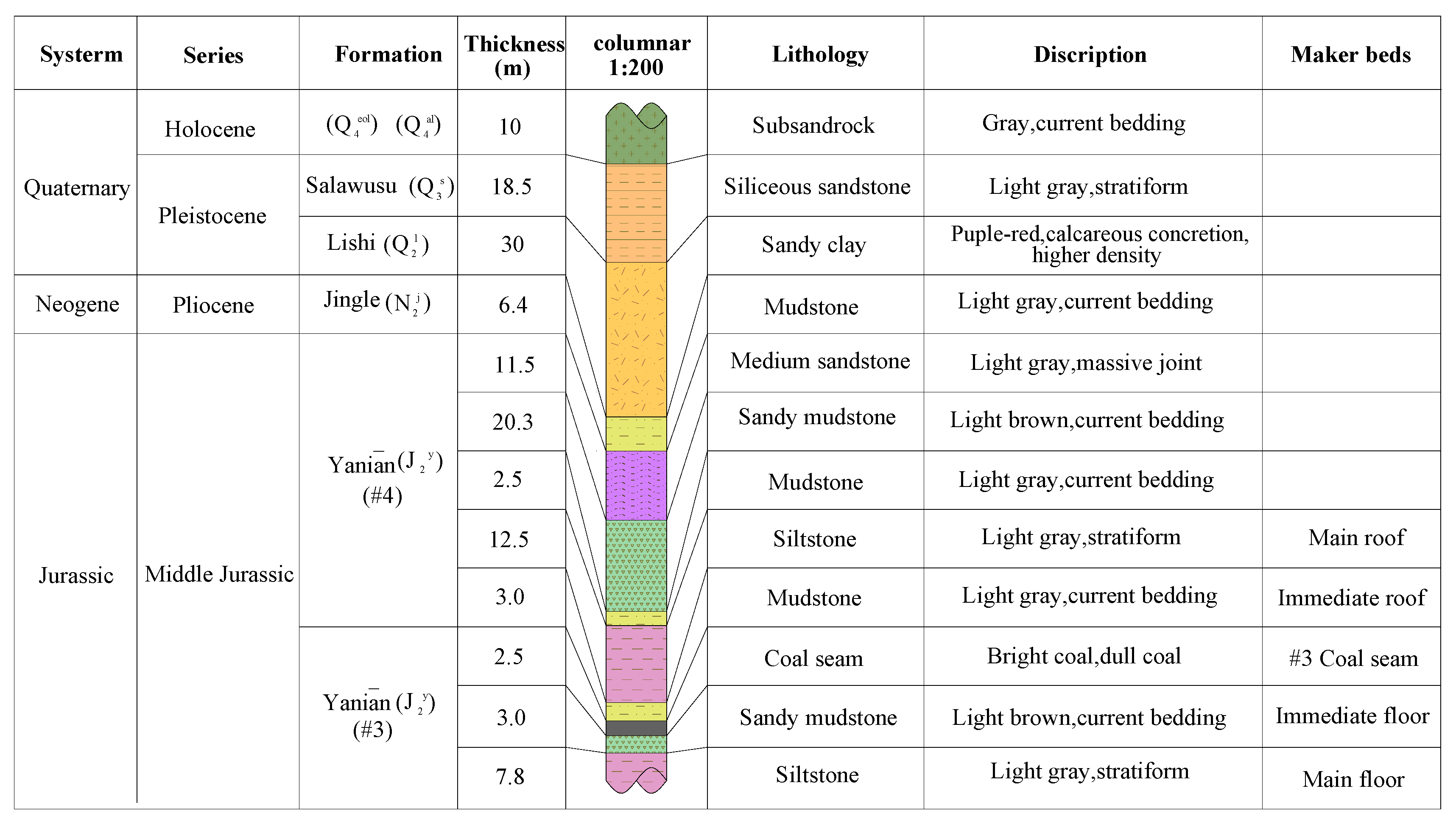
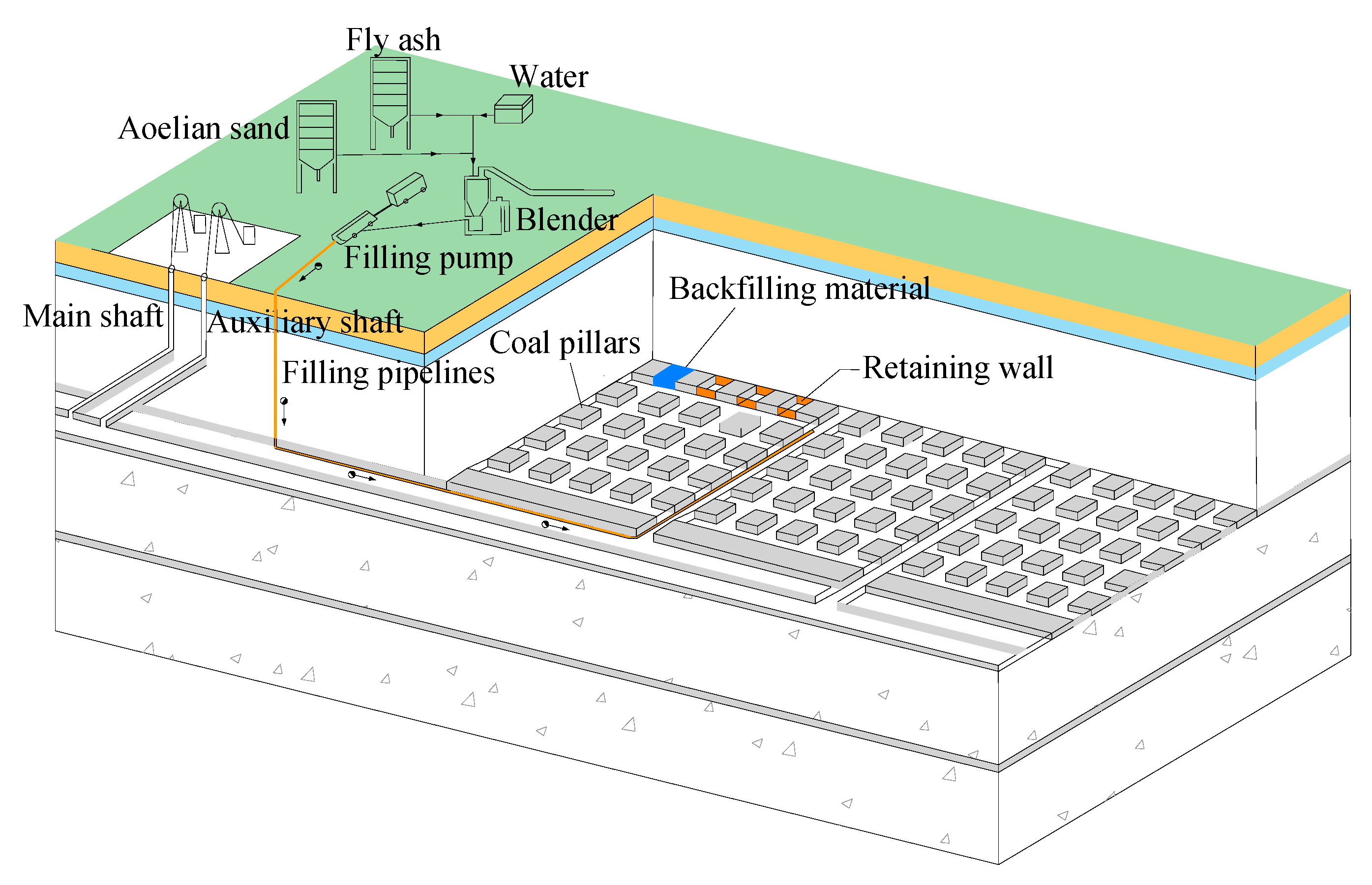

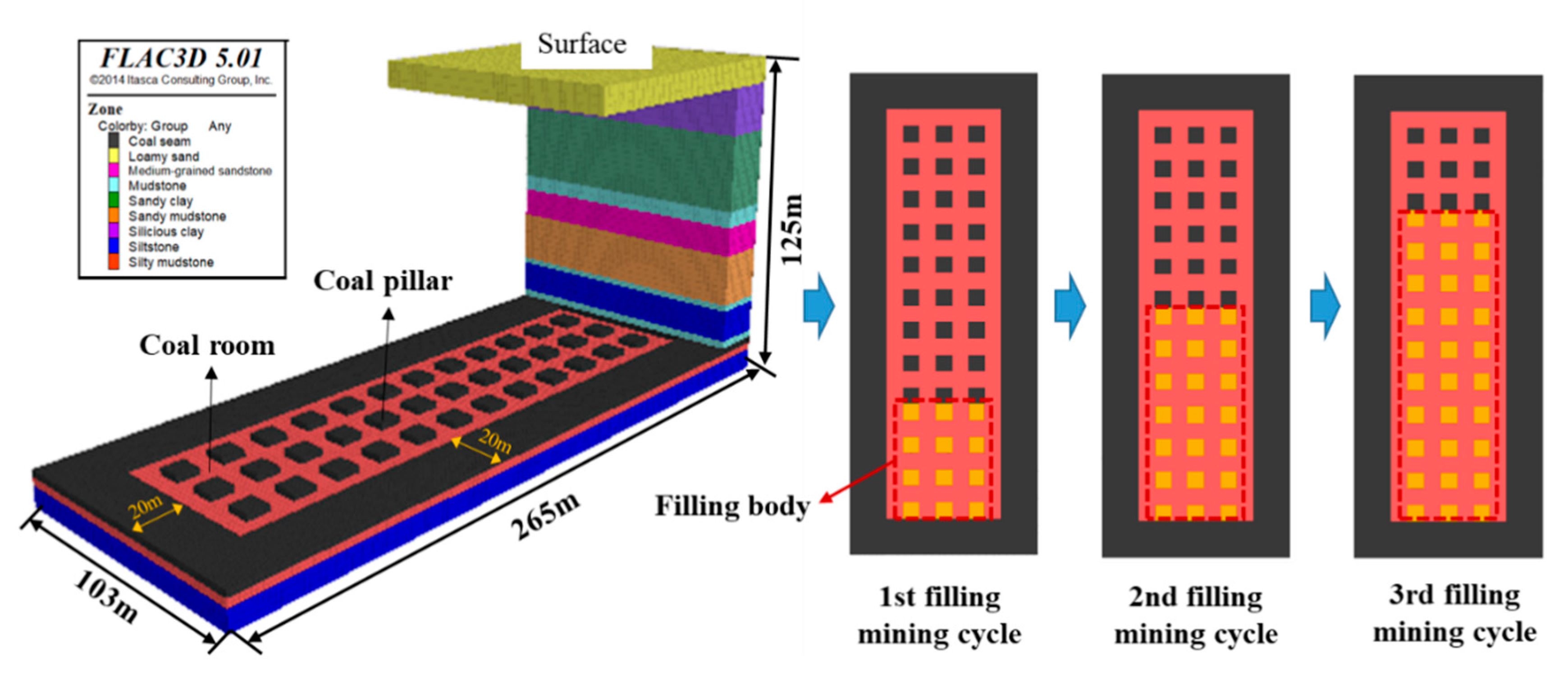
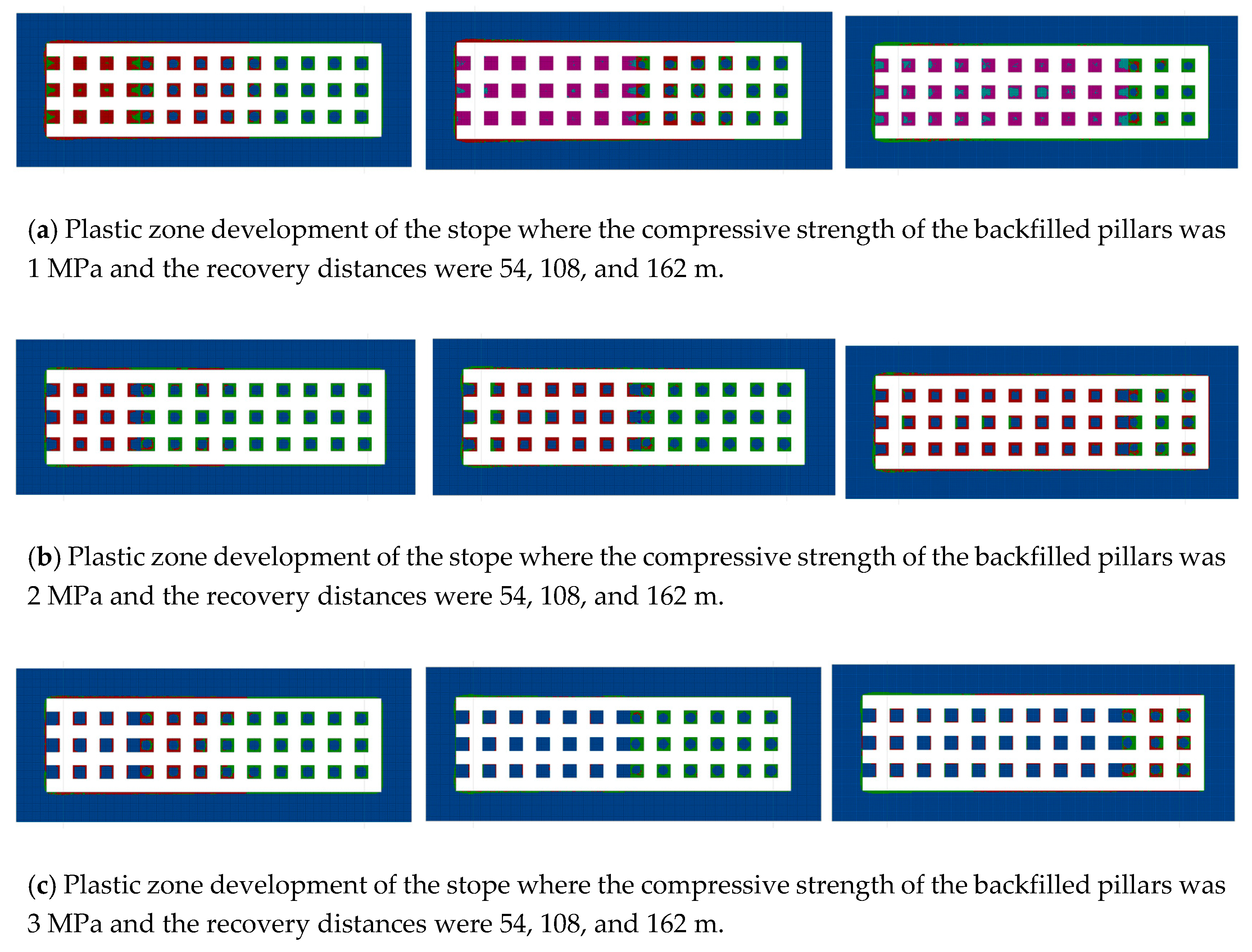

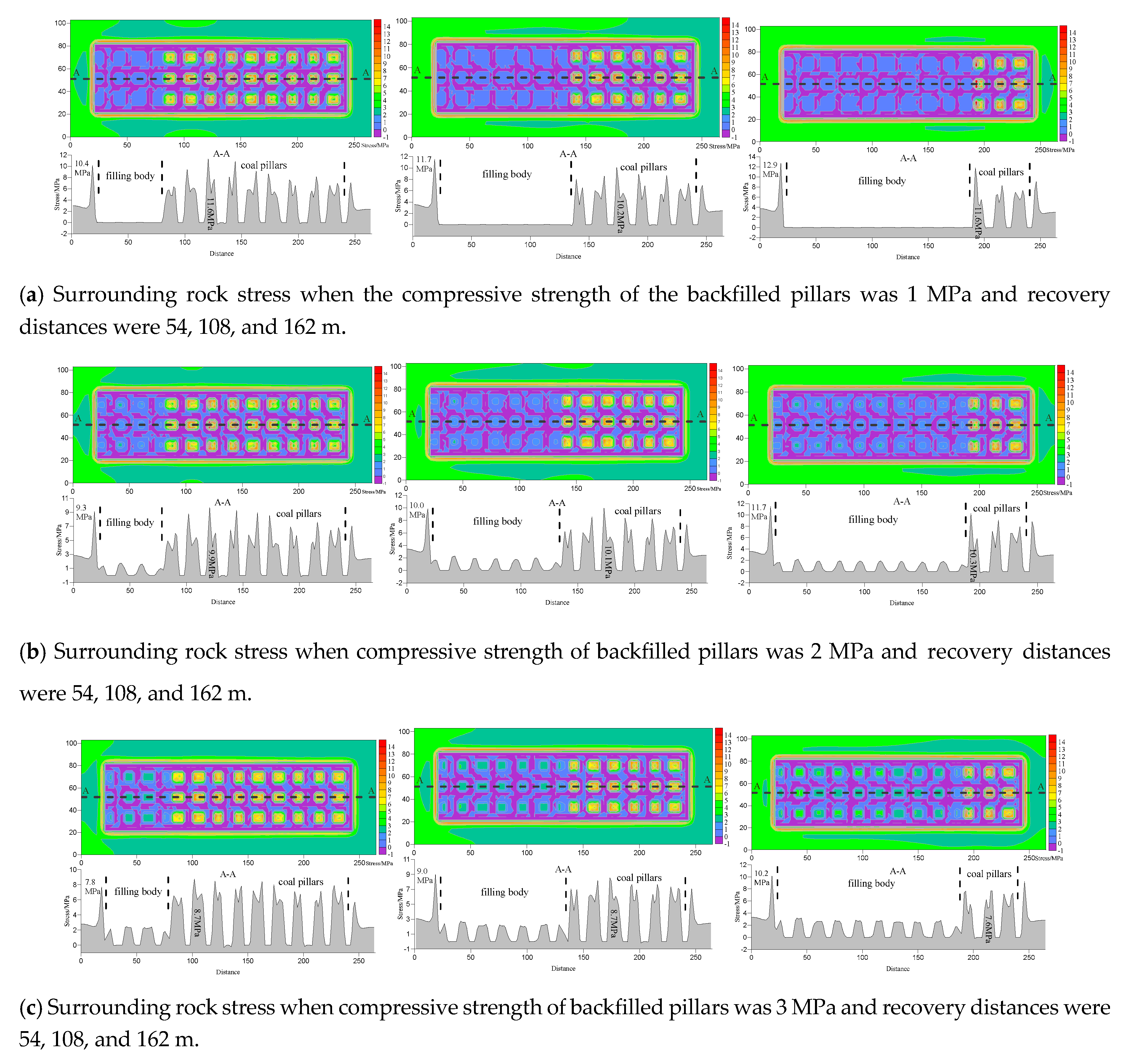
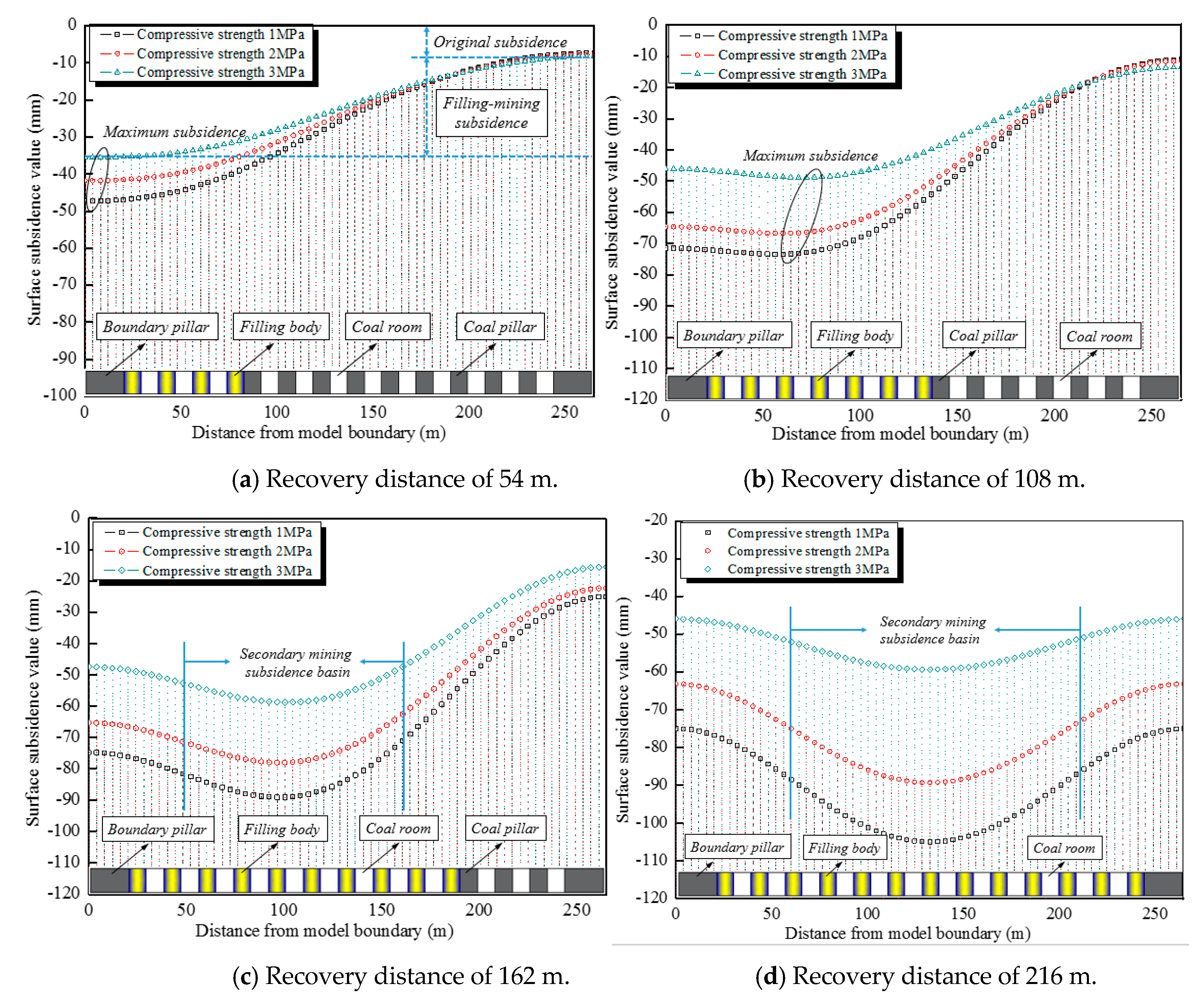

| No. | Concentration (%) | Fly Ash (%) | Aeolian Sand (%) | Cement (%) | Quicklime (%) |
|---|---|---|---|---|---|
| A1 | 72 | 47.5 | 44.5 | 8 | 0 |
| A2 | 72 | 47.5 | 39.5 | 8 | 5 |
| A3 | 72 | 47.5 | 34.5 | 8 | 10 |
| A4 | 72 | 52.5 | 34.5 | 8 | 5 |
| A5 | 72 | 42.5 | 44.5 | 8 | 5 |
| A6 | 72 | 47.5 | 41.5 | 6 | 5 |
| A7 | 72 | 47.5 | 43.5 | 4 | 5 |
| A8 | 74 | 47.5 | 39.5 | 8 | 5 |
| A9 | 76 | 47.5 | 39.5 | 8 | 5 |
| No. | 28 d Strength (MPa) | Bleeding Rate (%) | Slump Rate (mm) |
|---|---|---|---|
| A1 | 1.76 | 13.80 | 220 |
| A2 | 2.23 | 12.07 | 214 |
| A3 | 1.91 | 10.06 | 210 |
| A4 | 2.55 | 10.54 | 203 |
| A5 | 2.29 | 13.83 | 199 |
| A6 | 1.56 | 11.67 | 208 |
| A7 | 1.15 | 15.39 | 215 |
| A8 | 2.76 | 7.68 | 201 |
| A9 | 3.02 | 5.84 | 178 |
| No. | Rock Stratum Name | Bulk Modulus (GPa) | Shear Modulus (GPa) | Tensile Strength (MPa) | Cohesion (MPa) | Internal Friction Angle (°) | Density (kg/m3) |
|---|---|---|---|---|---|---|---|
| 1 | Clayey silt | 0.08 | 0.05 | 0.05 | 0.1 | 16.0 | 1670.0 |
| 2 | Silica sand | 0.12 | 0.08 | 0.1 | 0.5 | 18.0 | 1800.0 |
| 3 | Sandy clay | 0.8 | 0.31 | 0.8 | 0.7 | 25.0 | 1600.0 |
| 4 | Mudstone | 0.6 | 0.32 | 0.8 | 0.6 | 27.0 | 1600.0 |
| 5 | Medium-grained sandstone | 1.60 | 1.14 | 1.0 | 2.3 | 32.0 | 2100.0 |
| 6 | Sandy mudstone | 0.63 | 0.50 | 0.6 | 1.0 | 28.0 | 2200.0 |
| 7 | Mudstone | 0.6 | 0.32 | 0.8 | 0.6 | 27.0 | 1600.0 |
| 8 | Siltstone | 1.87 | 1.12 | 1.0 | 2.0 | 30.0 | 2615.0 |
| 9 | Mudstone | 0.6 | 0.32 | 0.8 | 0.6 | 27.0 | 1600.0 |
| 10 | Coal seam | 0.80 | 0.41 | 1.86 | 0.3 | 25.0 | 1400.0 |
| 11 | Sandy mudstone | 0.63 | 0.50 | 0.6 | 1.0 | 28.0 | 2200.0 |
| 12 | Siltstone | 1.87 | 1.12 | 1.0 | 2.0 | 30.0 | 2615.0 |
| Compressive Strength (MPa) | Bulk Modulus (GPa) | Shear Modulus (GPa) | Tensile Strength (MPa) | Cohesion (MPa) | Internal Friction Angle (°) | Density(kg/m3) |
|---|---|---|---|---|---|---|
| 1 | 0.07 | 0.03 | 0.145 | 0.23 | 21.0 | 1670.0 |
| 2 | 0.09 | 0.04 | 0.175 | 0.31 | 24.0 | 1760.0 |
| 3 | 0.12 | 0.06 | 0.211 | 0.59 | 28.0 | 1736.0 |
© 2019 by the authors. Licensee MDPI, Basel, Switzerland. This article is an open access article distributed under the terms and conditions of the Creative Commons Attribution (CC BY) license (http://creativecommons.org/licenses/by/4.0/).
Share and Cite
Zhou, N.; Yan, H.; Jiang, S.; Sun, Q.; Ouyang, S. Stability Analysis of Surrounding Rock in Paste Backfill Recovery of Residual Room Pillars. Sustainability 2019, 11, 478. https://doi.org/10.3390/su11020478
Zhou N, Yan H, Jiang S, Sun Q, Ouyang S. Stability Analysis of Surrounding Rock in Paste Backfill Recovery of Residual Room Pillars. Sustainability. 2019; 11(2):478. https://doi.org/10.3390/su11020478
Chicago/Turabian StyleZhou, Nan, Hao Yan, Shuyin Jiang, Qiang Sun, and Shenyang Ouyang. 2019. "Stability Analysis of Surrounding Rock in Paste Backfill Recovery of Residual Room Pillars" Sustainability 11, no. 2: 478. https://doi.org/10.3390/su11020478
APA StyleZhou, N., Yan, H., Jiang, S., Sun, Q., & Ouyang, S. (2019). Stability Analysis of Surrounding Rock in Paste Backfill Recovery of Residual Room Pillars. Sustainability, 11(2), 478. https://doi.org/10.3390/su11020478






